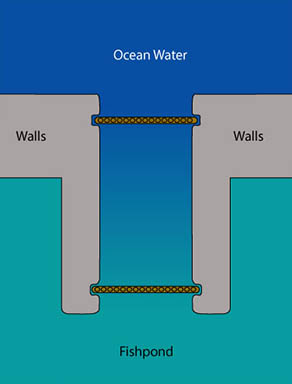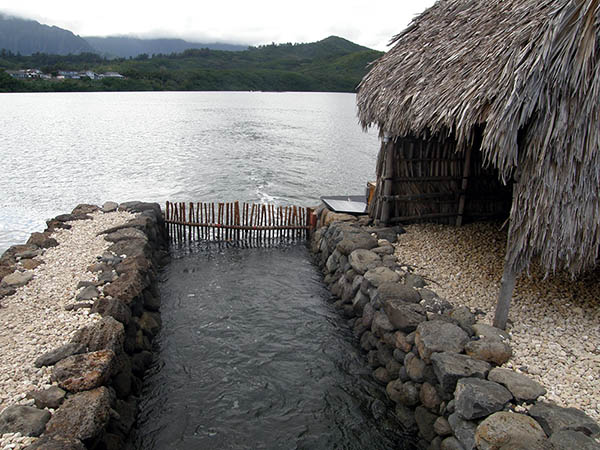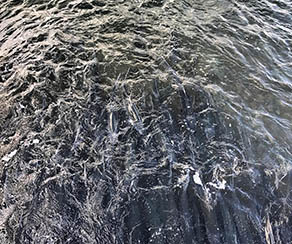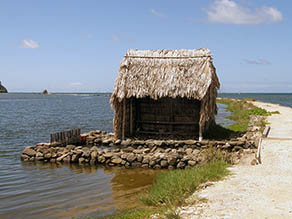 |
 |
 |
|||||
|
Mākāhā:
“Hawaiian words have great functionality to them,” Keahi explains. “We’re sitting at the mākāhā, and when you have a word and you are really just wondering ‘Why? Why did they use this word? Why did they make this word up?’ You go through a system called makawalu and it’s to look at all angles of the word to try to determine the outcome, and maybe the reasoning why they gave it that name. If you look in the dictionary, it says mākāhā. Kahakō [macrons] go over all the a’s. And it’s it simply means a "sluice gat"e in the dictionary and they don’t give a much bigger term than that to this area. But when you remove the kahakō’s and you break down the word, you end up with something a little different, and knowing our kūpuna, they worked these systems from mauka to makai. “A lot of times, when you go after trying to find out more about your Hawaiian side, you usually end up in a lo‘i. Specially for me, I was in the lo‘i a lot more than I was in a fish pond before I started working here. And I think about the parts of the lo‘i: each lo‘i has a makawai. That’s the entrance where water comes in and out of each lo‘i. It makes sense because makawai are one directional: they’re going downstream. Here we have a little different circumstance. We have a maka—just like the makawai there—but our maka is not one directional. Our maka is what allows this fish pond to circulate. Our maka is something more than just a sluice gate to me, and that's where that hā comes in. It's this opening it's this area that breathes for our pond. 
“Hā is that breath you take. So that just like our breath, this hā, as the tide drops, water starts going out of the fish pond taking that breath out. And as the tide rises back up, we have that intake of clean, fresh, salt water. It’s just like that hā that we breathe in and out, that breath that we taking. And that's the basis of life. You need these things. Again, there’s functionality in this: without this, either the pond would be completely stagnant. If they just built walls and didn't allow the space to breathe, I don't think you’d create a very good condition for fish to grow. So what they did was create these these mākāhā and allowed this place to breathe. “The first the first thing we share with the people who come here is the recruiting aspect of the mākāhā. I talked to a farmer on the Big Island who raises cattle, and he prided himself on the grass he grew. Because he was in Kona, it is hot. If grass doesn’t grow good, his cows aren’t going to be fed and they’re not going to get as big as he wants them to be. And so he prided himself on that, on his ‘āina—he had it worked out so that his grass and his rotations were perfect for his cows, and his cows were getting healthy very quickly. This made me realize that in our fish pond, we are really phytoplankton farmers. We need to produce quality phytoplankton. And all that that takes—and this is what connects us back to our ahupua‘a—is good water fresh water. Without our fresh water we’re not going to have those nutrients that bloom phytoplankton.
“Our mākāhā are set up with double gates: one on the kai side, one on the pond side. We lift up on the pond-side gate and the mākāhā fills up, then we drop the gate and enclose our catch within a ten- to fifteen-foot area. So the kūpuna have taken the whole ocean and shrunk it a little bit by making a fish pond of eighty-eight acres, that betters their chances. But now they're perfecting their chances by allowing the fish to come into mākāhā, and so their pick is within ten feet. They said the backs of the fish in these mākāhā were out of the water—their mākāhā were filling up so much that the backs of the fish were sticking out of the water. They pretty much said they were harvesting by hand. At that point, when it's that packed with fish, you're picking and choosing exactly what you want and the food is coming right to you. “If we don’t have the front gates of our mākāhā in, and we let the fish the fish come right in here, they’ll just hang out. We had a storm Darby that came through a few months ago or so. Rainwater came down and we got the break in our wall. It’s never from the ocean. Damage happens because it rains, the pond fills up with water, and debris comes down with that. The back of our wall wasn’t fully restored yet, so a lot of water and debris came right through the mangrove and broke a bunch of our gates. After a while we’re slowly getting our gates back in and there’s been a school of ‘ō‘io that was going in and out while we were fixing our gates—the mākāhā nui, the third mākāhā out here. “We’ve got all the gates back in, but under one of the gates there was about a two-foot hole. For two months we didn’t fix that hole, and every day the ‘ō‘io and the ‘awa would come up to it and just sit in that nice fresh current But when the current changed, they’d turn around and go right back into the pond. They never tried to leave through that hole. So it proves to us that this is a great environment for them. Yes, they would like more salt water, you can tell: they’re just sitting in that wake of fresh water, and right when the tide changes, like clockwork they turn around and go right back into the pond. So there’s some good things happening in this place.” “I know on Moloka‘i,” Keli‘i says, “some of the ponds that they have over there, once built, certain families were assigned and allowed to harvest at certain mākāhā. They were responsible for the up-keep and then harvest and sharing of a particular mākāhā. We have seven locations for mākāhā now, maybe there were six, I don’t know before a hundred years ago if there are always six because all of our mākāhā have been modernized in the early 1900’s. Concrete was added so I’m not sure if they were ever less than six or more, but at least we have seven now. When I started working here there were six because we added in our own last year. “For the hale [houses] out there, they would have figured out some sort of rotation in terms of harvesting or sharing of the harvest. There probably was a person or a family, like a konohiki, who would have maybe set the kapu [taboo] on the seasons, knowing the spawning cycles. And you would have had those either head fisherman or head kia‘i loko, who were in tune and who are generational and they have that encyclopedia of knowledge to set the boundaries on harvesting. “But the maintenance of the fishpond and traditional infrastructure, I think a few families and then the community at some point would have been involved in the sharing of the bounty.” |
|
|||||
|
|||||




